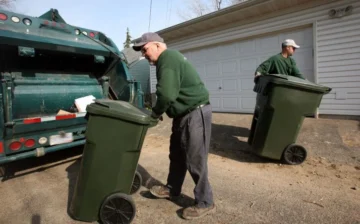
The moving industry is enormous in the United States, with a total market size of $19 billion, over 18,000 moving companies, and more than 109,000 workers. More than 15 million families, or 27 million people, move each year.
With all that activity, you might think the moving industry generates a lot of waste, and you’d be right. Between cardboard boxes, packing supplies, and fuel, moving consumes enormous resources and produces tremendous waste.
Many people nowadays are focused on sustainable living and trying to efficiently use resources. Sustainability helps the environment and also enables you to save money.
This post will describe how much waste is produced in moving and offer some suggestions for reducing it. With the cost of materials going way up, it makes sense to conserve as much as possible. If you’re planning a move, this post will help you make a more efficient and eco-friendlier move and lower your moving costs.
How Much Waste Does Moving Create?
The moving website move Buddha estimates that each year the moving industry consumes:
- 900 million cardboard boxes
- 90 million pounds of packing paper
- 30 million rolls of tape
- 353 million gallons of fuel
Additionally, there’s 345,000 tons of food that gets discarded because it can’t be moved, and 8.4 million tons of other stuff in customers’ homes and storage that gets thrown out on or before moving day.
That’s a lot of waste.
All of this material consumption takes up precious resources and increases your moving costs. If you want to reduce your impact on the environment during your next move, here are some ideas.
How to Reduce Waste in Moving
Reduce Cardboard Box Use
Cardboard boxes are a staple of the moving business, but there are lower cost alternatives to buying new boxes. The average move costs upward of $800, and if you buy new cardboard boxes, you may spend over $150 just on those.
There are many ways to get used cardboard boxes for your next move. You can visit stores that receive lots of shipped goods, like supermarkets, bookstores, department stores, and home improvement stores. Check box exchanges at U-Haul. You can also check sites like Craigslist, Freecycle, and Nextdoor for free boxes being offered. Sites like Ecobox receive used boxes and sell them at a considerable discount. Also check with college dormitories and any neighbors who have just moved to see whether there are any leftover boxes.
Just be careful when getting used boxes to ensure they’re sturdy enough for what you plan to carry.
Instead of cardboard boxes, you can also consider buying or renting plastic moving bins. Unlike cardboard boxes, these can be used and reused for years. Also, suitcases are an excellent way to pack clothes and shoes.
Reduce Purchases of Packing Materials
Packing paper is a more sustainable option for packing boxes than peanuts, bubble wrap, and Styrofoam pads.
But instead of buying new packages of packing paper to fill empty spaces in boxes or bins and protect fragile items, consider using clothes, towels, and linens. Wrap small glasses in socks. Put dish towels and shirts between plates. Use socks to pack glasses. Pack tee shirts between plates. Wrap lamps and electronics in blankets or put pillows around them. This will help you save on packing supplies.
You can also save magazines, newspaper, and bubble wrap and peanuts from items you receive in the mail and use those for your next move.
Also consider purchasing biodegradable packing tape. Several companies offer plant-based, renewable and compostable packing tape and peanuts. If you’re using plastic bins instead of cardboard boxes, this will also help you reduce your use of packing tape.
Reduce Food Waste
As we mentioned, a lot of food is wasted in moving to the tune of about 345,000 tons per year. In the weeks leading up to moving day, consider creating and following a plan to consume as much perishable food as possible and clean out the refrigerator and freezer.
If you have any unopened, nonperishable canned or boxed food that will not be moving with you, Move For Hunger is a national organization that teams with moving companies to collect usable food and donate it to a local food bank.
Declutter Before Moving
Before moving, go through your belongings and decide what to move. Other items you can sell or donate if possible. A moving sale is a good way to get rid of things you won’t need after the move but that someone else could use. It can also help you raise money for your move.
For items that you don’t sell, consider donating to local organizations. Old sheets, towels, and blankets can be taken to animal shelters. Books, business attire, and office supplies can go to shelters, schools, or charitable organizations.
Minimize Your Fuel Consumption
By decluttering before a move, you can reduce the total amount of household goods you’ll be moving. This will increase the moving company’s efficiency and save you on the cost of moving. If you’ll be moving some items yourself, try to plan your route to avoid redundant trips.
Team With a Green Moving Company
The sustainability movement has taken hold in the moving industry. There are many green moving companies that focus on moving efficiently while reducing the impact on the environment. Green moving companies typically use reusable plastic moving bins instead of cardboard boxes. These bins are self-sealing, so you don’t need to use packing tape. They encourage the use of linen, towels, and clothing items for padding instead of packing paper or Styrofoam.
Green movers use moving trucks that are powered by biodiesel fuel instead of diesel. Regular diesel fuel releases toxic byproducts into the air; biodiesel fuel comes from natural sources and is non-toxic and biodegradable. Green movers also may have partnerships with local donation sites for you to donate clothing, appliances, furniture, and other items.
And if you need storage during your move, green movers can refer you to green storage facilities. Green storage facilities typically consist of single warehouses filled with recyclable, renewable wooden containers. This allows for more efficient use of space than individual storage units.
Green storage facilities also may have plenty of windows and skylights for natural light to minimize energy consumption during the day, and efficient insulation to reduce the need for heating and air conditioning. Because green storage facilities charge based on the space actually used, you may save money.
Recycle
After your move is done, consider reusing or recycling your moving supplies. Cardboard boxes can be taken to recycling facilities or U-Haul may accept them. Some recycling facilities will accept packing paper and bubble wrap. If you can’t recycle these, consider keeping them for your next move or when you need to pack and ship items.
Because of the enormous amount of resources that moving consumes and the amount of waste generated each year, many people are looking for ways to reduce waste and help the planet. The tips in this post can help you lower your impact on the environment and save on moving costs.
We hope you found this post, How Much Waste Does Moving Create, useful. Be sure to check out our post Eco Movers and Eco-Friendly Moving Tips for more great information.
Have Experience in the Moving Industry? Want an Additional Income Stream? Work With All Around Moving!
Are you possessing experience in the shipping industry? Or maybe in the moving industry? Are you looking for additional Income stream? Read All Around Moving’s opportunity that is just for you!
This program, affords experienced moving consultants with the unique opportunity to develop their moving & relocation consultant business from anywhere, any city U.S.A.
Get with a complete set-up to run your business. To learn more, click here.





